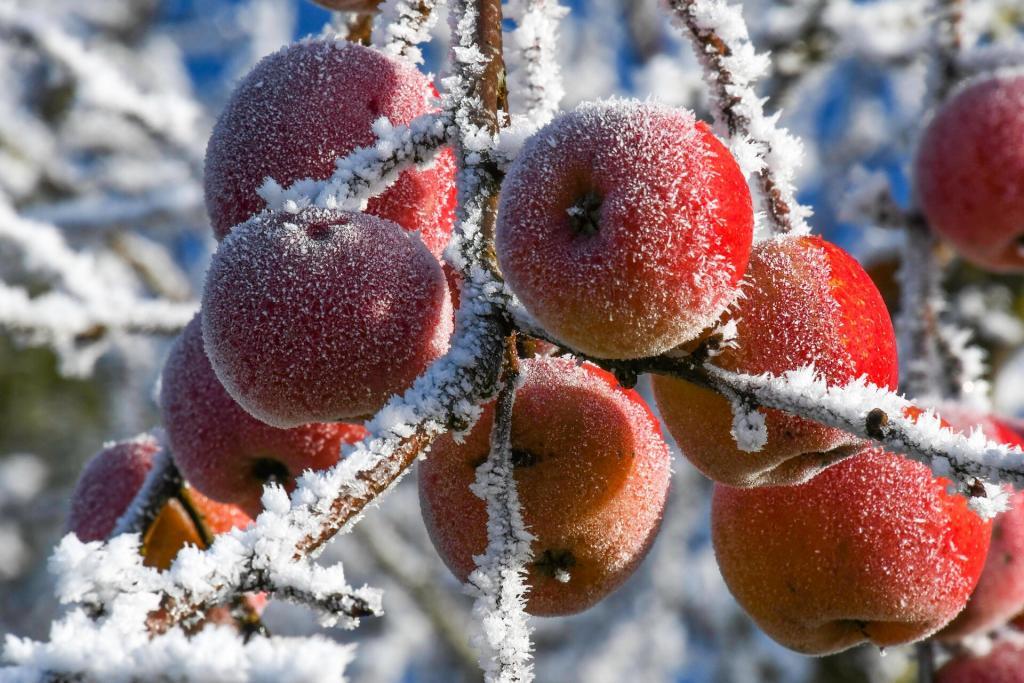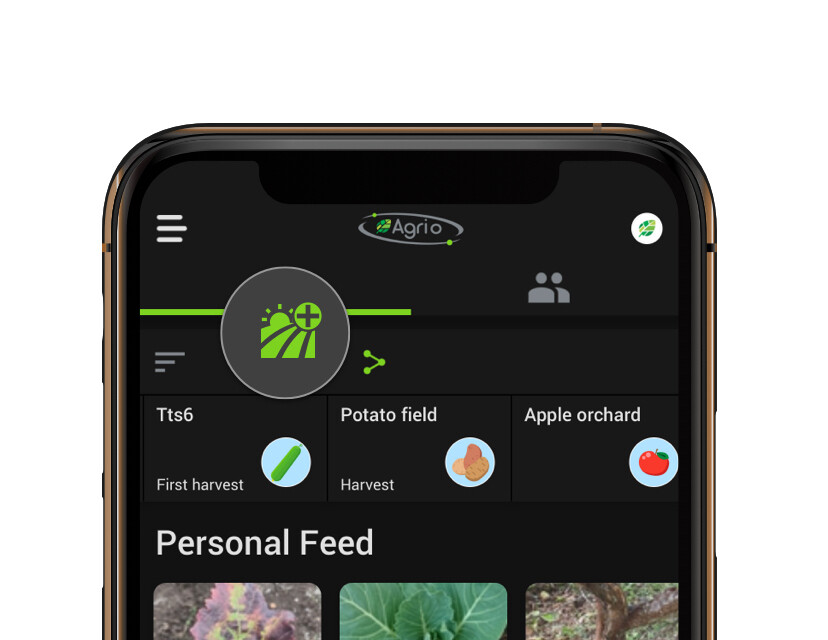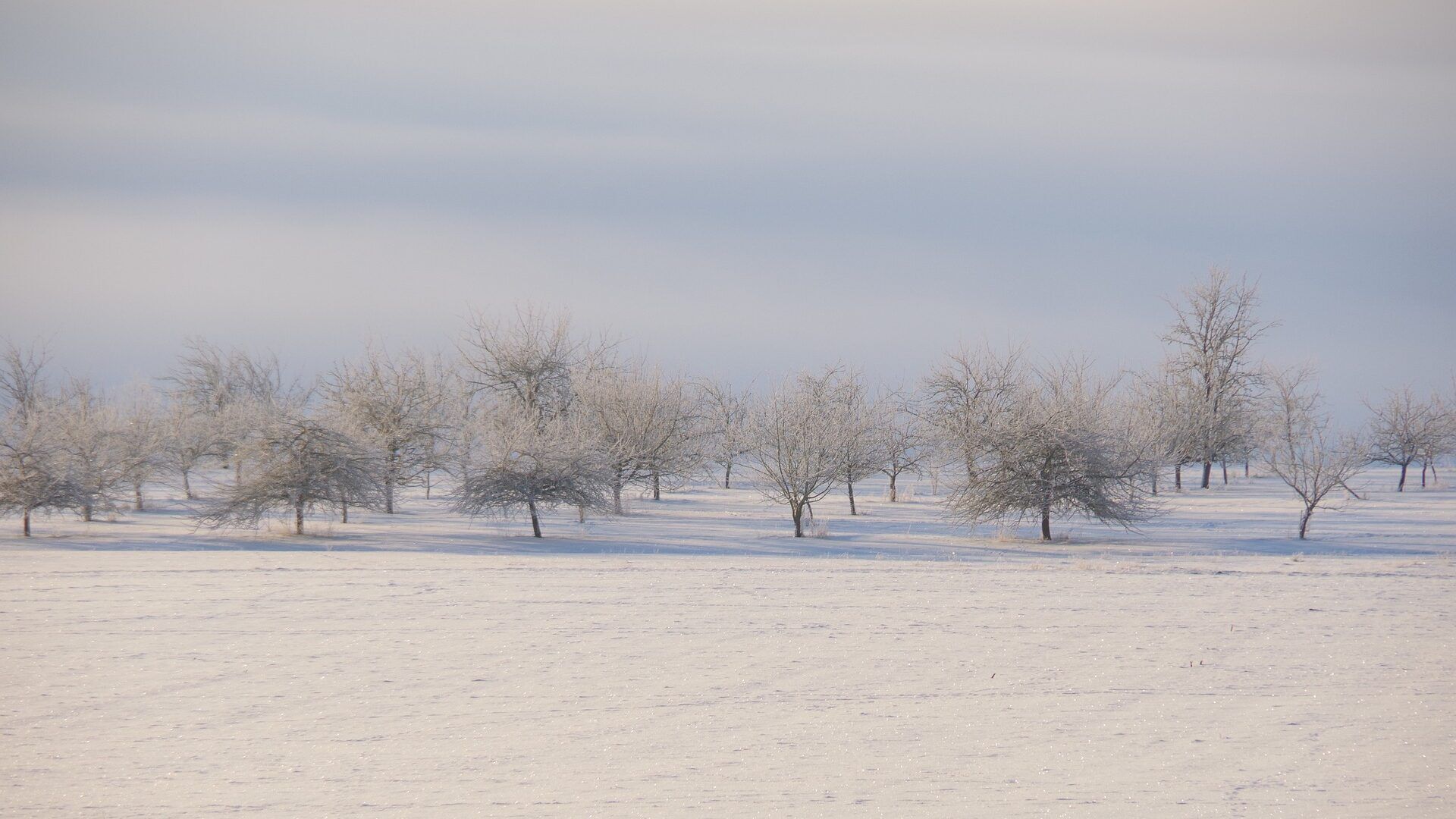An app that tracks chill hours and simplify fruit tree selection
Fruit trees require a certain amount of winter chill to produce fruit. This period of cold temperatures is necessary for the tree to properly go through the process of dormancy, which is essential for the tree’s overall health and fruiting potential. Different fruit tree varieties have different chill hour requirements, and it is important to choose a variety that is well-suited to the climate in which it will be grown. An app that serves as chill hours calculator and tracks chill hours in real-time, with hyperlocal accuracy, offers a better method than tracking chill hours by zip code, aiding in choosing suitable varieties.
If a fruit tree does not receive enough winter chill, it may have problems producing fruit or produce fruit of poor quality. On the other hand, if a fruit tree receives too much winter chill, it may be damaged or have reduced fruiting potential. By choosing a fruit tree variety that is appropriate for the expected chill hours in your area, you can help ensure that the tree will thrive and produce high-quality fruit.

Many fruit trees require a certain amount of winter chill to produce fruit, including:
- Apple trees: Apple trees are native to temperate regions of the Northern Hemisphere and are well-suited to cool, moist climates. They require between 500 and 1200 chill hours and are tolerant of frost.
- Apricot trees: Apricot trees are native to the Northern Hemisphere’s temperate regions and are well-suited to warm, dry climates. They require between 300 and 800 chill hours and are sensitive to frost, damaging the flowers and affecting fruit production.
- Cherry trees: Cherry trees are native to temperate regions of the Northern Hemisphere and are well-suited to cool, moist climates. They require between 500 and 1000 chill hours and are tolerant of frost.
- Peach trees: Peach trees are native to the Northern Hemisphere’s temperate regions and are well-suited to warm, humid climates. They require between 300 and 800 chill hours and are sensitive to extreme cold.
- Plum trees: Plum trees are native to temperate regions of the Northern Hemisphere and are well-suited to cool, moist climates. They require between 500 and 1000 chill hours and are tolerant of frost.
- Nectarine trees: Nectarine trees are a type of plum tree and have similar chill hour requirements. They are native to temperate regions of the Northern Hemisphere and are well-suited to cool moist climates. They require between 500 and 1000 chill hours and are tolerant of frost.
- Pear trees: Pear trees are native to temperate regions of the Northern Hemisphere and are well-suited to cool, moist climates. They require between 300 and 1000 chill hours and are tolerant of frost.
- Persimmon trees: Persimmon trees are native to warm, humid climates and are well-suited to subtropical and tropical regions. They have low chill hour requirements and can grow in areas with as few as 100 chill hours.
- Pecan trees are native to the southern United States and are well-suited to warm, humid climates. They require a certain amount of winter chill to produce a good crop of nuts, typically between 300 and 800 chill hours. Pecan trees are also sensitive to extreme cold and can be damaged by temperatures below -20°F (-29°C).
- Almond trees: Almond trees are native to the Mediterranean region and require a warm, dry climate with mild winters. They need between 200 and 600 chill hours and are sensitive to frost, damaging the flowers and affecting nut production.
- Walnut trees: Walnut trees are native to temperate regions of the Northern Hemisphere and are well-suited to cool, moist climates. They require between 800 and 1200 chill hours and are tolerant of frost.
- Hazelnut trees: Hazelnut trees are native to the temperate regions of Europe and Asia and are well-suited to cool, moist climates. They require between 500 and 1000 chill hours and are tolerant of frost.
- Chestnut trees: Chestnut trees are native to the Northern Hemisphere’s temperate regions and are well-suited to cool, moist climates. They require between 500 and 1000 chill hours and are tolerant of frost.
It is important to choose the right variety of these trees for your climate, considering the expected chill hours in your area. For example, if you live in a region with mild winters, you may want to choose a tree variety that requires fewer chill hours. On the other hand, if you live in a region with very cold winters, you may want to choose a fruit tree variety that is better suited to withstand those conditions.

How to compute chill hours?
The formula for calculating chill hours, also known as chill units, is based on the number of hours that the temperature is between 32°F (0°C) and 45°F (7.2°C) during the winter months. This period of cold temperatures is necessary for fruit trees to properly go through the process of dormancy, which is essential for their overall health and fruiting potential.
To calculate the chill hours for a particular location, you will need to track the temperature data for a period of time. You can use a thermometer or other temperature-tracking device to measure the temperature at regular intervals, such as once per hour, and record the data. You can then use the following formula to calculate the total number of chill hours:
Chill hours = (Number of hours with temperature between 32°F and 45°F) x (Number of days)
For example, if the temperature was between 32°F and 45°F for 10 hours per day for a total of 90 days, the total number of chill hours would be:
Chill hours = (10 hours/day) x (90 days) = 900 chill hours
When should I start tracking the chill hours?
The time period for tracking chill hours will vary depending on the climate in your region. In general, chill hours are typically measured from November to March in the Northern Hemisphere and from May to September in the Southern Hemisphere. These months correspond to the winter season in the respective hemispheres and typically have the lowest temperatures of the year.
To determine the specific time period for tracking chill hours in your region, you will need to consider the typical temperature range during the winter months and the chill hour requirements of the fruit tree varieties you are interested in growing. You can use a thermometer or other temperature-tracking device to measure the temperature at regular intervals, such as once per hour, and record the data. You can then use the formula above to calculate the total number of chill hours for your location.
It is also important to note that the time period for tracking chill hours may vary slightly depending on the specific climate conditions in your region. For example, if your region has a relatively mild winter with few frosty nights, you may need to track chill hours over a longer period to get an accurate measurement. On the other hand, if your region has a very cold winter with many frosty nights, you may be able to track chill hours over a shorter period.
In general, it is a good idea to consult with a local nursery or extension office to get specific recommendations for tracking chill hours in your area. They can provide you with more detailed information about your region’s climate conditions and help you determine the best time period for tracking chill hours based on your specific needs.
Timing interventions with the aid of chilling hours calculator
There are several interventions that farmers may use to help ensure that their fruit trees receive the appropriate amount of winter chill. These interventions may be used to supplement natural chill hours or limit chill hours to fruit trees growing in regions with severe winters. Some common interventions include:
- Using cold frames or other protective structures: Cold frames or other protective structures can help keep fruit trees warm during the winter months while still allowing them to receive natural chill hours. These structures can be especially useful for protecting young or tender trees from extreme cold.
- Watering trees during dry spells: Providing adequate moisture to fruit trees during the winter months can help prevent drought stress, which can reduce the tree’s ability to produce fruit. Watering trees during dry spells can help ensure they have the moisture needed to thrive.
- Using windbreaks or other protective measures: Windbreaks or other protective measures can help reduce the impact of cold winds on fruit trees, helping to keep them warm and protected during the winter months.
- Applying mulch or other protective materials: A layer of mulch or other protective materials around the base of fruit trees can help insulate the roots and prevent them from freezing. This can help protect the tree’s overall health and increase its chances of producing fruit.
In general, it is important for farmers to carefully monitor the chill hours their fruit trees receive and to take appropriate action to ensure that the trees receive the appropriate amount of winter chill. Depending on the trees’ specific needs and the region’s climate conditions, this may involve using one or more of the interventions described above.
A few substances may help “wake up” fruit trees after the winter dormancy period. These substances are typically applied in the spring after the trees have received the appropriate amount of winter chill, to stimulate new growth and improve the tree’s overall health. Some common substances used for this purpose include:
- Nitrogen-rich fertilizers: Nitrogen is an essential nutrient necessary for fruit trees’ growth and development. Applying a nitrogen-rich fertilizer in the spring can help stimulate new growth and improve the tree’s overall health.
- Growth hormones: Certain growth hormones, such as auxins and cytokinins, can help stimulate new growth and improve the tree’s overall health. These hormones are typically applied in a spray or other treatment and can effectively promote new growth in fruit trees.
- Pruning fruit trees in the spring can help remove damaged or diseased branches, encourage new growth, and improve the tree’s overall health. Pruning should be done carefully, following proper techniques, to avoid damaging the tree.
It is important to note that these substances and practices should be used with caution and following the tree’s specific needs and the region’s climate conditions. Overuse or improper application of these substances or practices can damage the tree or reduce its overall health and productivity.
Why is it important to time it according to the chill hours?
If a fruit tree has not received enough winter chill, it may not be fully dormant and may not respond well to substances or practices intended to stimulate new growth. On the other hand, if a fruit tree has received too much winter chill, it may be damaged or may have reduced fruiting potential. By timing the application of these substances or practices according to the chill hours, you can help ensure that the tree is in the optimal state for new growth and that it will benefit from the treatment.
It is important to carefully monitor the chill hours that your fruit trees receive and to use the appropriate substances or practices at the appropriate time to help the trees thrive and produce high-quality fruit.
How can I find out how many chill hours my tree variety needs?
There are a few different ways to find out how many chill hours your fruit trees need:
- Consult a gardening or fruit tree growing guide: Many gardening or fruit tree growing guides provide information about the chill hour requirements of different fruit tree varieties. You can use these guides to help determine which varieties are most suitable for your climate.
- Check with a local nursery or extension office: Local nurseries and extension offices can provide information about the chill hour requirements of different fruit tree varieties and help you determine which varieties are most suitable for your climate.
- Calculate the chill hours for your location: You can use a thermometer or other temperature-tracking device to measure the temperature at regular intervals, such as once per hour, and record the data over a period of time, typically from November to March in the Northern Hemisphere or from May to September in the Southern Hemisphere. You can then use the formula above to calculate the total number of chill hours for your location.
It is important to note that the chill hour requirements of fruit tree varieties can vary depending on the specific climate conditions in your region. It is a good idea to consult with a local nursery or extension office to get specific recommendations for your area. They can provide you with more detailed information about your region’s climate conditions and help you determine the best fruit tree varieties for your specific needs.
What observations suggest that a tree finished the dormancy period?
There are a few signs that you can look for to determine if a fruit tree has finished the dormancy period:
- Buds start to swell: As the tree begins to come out of dormancy, the buds will start to swell, indicating that new growth is about to start.
- Leaves start to emerge: As the tree continues to come out of dormancy, the leaves will start to emerge from the buds. This indicates that the tree has finished the dormancy period and is ready for the growing season.
- Flowers start to bloom: Many fruit trees will start to produce flowers as they come out of dormancy. The blooming of flowers is often a good indicator that the tree has finished the dormancy period and is ready for the growing season.
It is important to note that the timing of these signs can vary depending on the specific climate conditions in your region and the tree’s specific needs. It is a good idea to consult with a local nursery or extension office to get specific recommendations for your area. They can provide you with more detailed information about your region’s climate conditions and help you determine when your fruit tree is likely to come out of dormancy.
Why tracking chill hours can be complicated and how the Agrio app chill hours calculator makes it easy
Tracking chill hours can be complicated and cumbersome for several reasons:
- It requires consistent monitoring: In order to accurately track chill hours, you need to measure the temperature at regular intervals, such as once per hour, over a period of time. This can be time-consuming and may require you to set up a temperature-tracking device or to manually record the temperature data.
- It requires accurate data: In order to calculate the total number of chill hours accurately, you need to ensure that you are recording the temperature data accurately and consistently. This can be challenging, especially if you are relying on manual methods or if you are working with equipment that is prone to error.
- It requires knowledge of the chill hour requirements of different fruit tree varieties: In order to choose the right fruit tree variety for your climate, you need to know the chill hour requirements of different varieties and how those requirements compare to the chill hours in your location. This can be confusing for those who are new to fruit tree growing or who are unfamiliar with the specific requirements of different varieties.
How does the chill hours calculator works
Once you draw your growing area on the map, Agrio calculates the accumulated chill hours for the last year and the current year. You can use last year’s data to determine which tree variety will perform optimally in your region.

Select the plot you just added and open the weather modal to review the information. The data is updated daily so that you can track the chill hours in real time.
Summary
The Agrio app can help with these challenges by providing a simple and convenient way to track chill hours and choose the right fruit tree variety for your climate. The app includes a temperature-tracking feature that allows you to record temperature data easily and calculates the total number of chill hours for your location. In addition, the Agrio app can track hyperlocal weather data, which can be especially useful for growing fruit trees in regions with microclimates or other variations in weather conditions. By tracking hyperlocal weather data, the Agrio app can provide you with more accurate and detailed information about the climate conditions in your specific location, which can be beneficial for choosing the right fruit tree variety and for optimizing the care and management of your trees. Overall, the Agrio app can be a valuable tool for those interested in tracking chill hours and choosing the right fruit tree variety for their specific needs.
